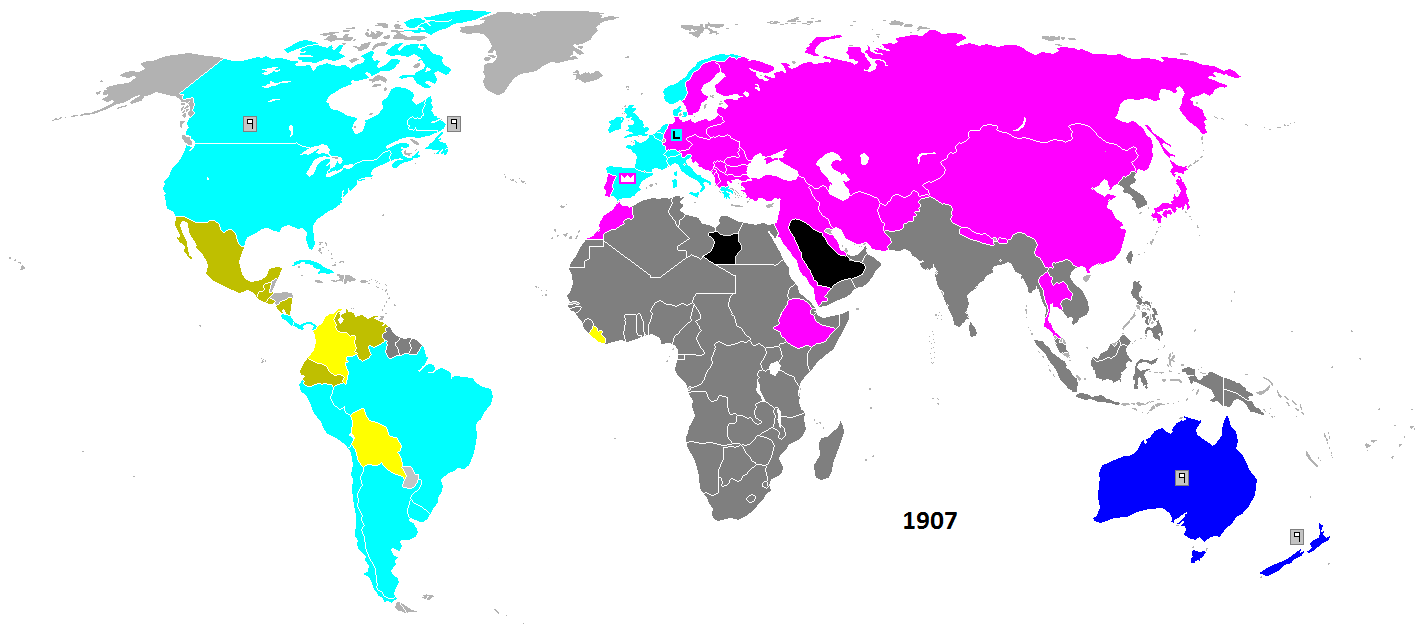
Chapter Nineteen
Fading Absolutism and Faking Democracy
By the beginning of the twentieth century, the general concept of limited, constitutional rule had become so prevalent that almost all monarchs had felt the pressure to go through the motions and pretend to listen to what their subjects had to say. And if the king still resisted pressure, the populace would likely insist. All over the world, educated, Westernized elites with modernist ideas launched pro-democracy uprisings against stubborn autocrats. Between 1905 and 1912, democratic upheavals shook Russia, Iran, the Ottoman Empire, Portugal, Mexico, and China. Most of these were snuffed out, or else they ricocheted and skipped off in unpredictable directions.Ⓐ
Japan and Russia
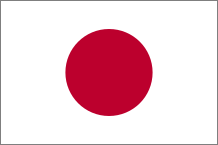 For centuries, the
emperor of Japan had been a ceremonial puppet of the nobility.
Japan’s aristocracy had locked out most foreign contact and
hadn’t let anything change in hundreds of years. Then in 1853 a
squadron of American warships under Commodore Matthew Perry
bullied its way into Tokyo’s harbor and showed the Japanese all
the fun toys they had been missing. This sparked a debate
and civil war between Japanese progressives and conservatives
that climaxed in 1868, when the new young Meiji Emperor
successfully asserted the crown’s authority over the nation, an
event known to history as the Meiji Restoration. Almost
immediately, the progressive new rulers began to drag Japan into
the modern world. They mined coal, built railroads and
steamships, printed newspapers and trained the army to fight
with repeating rifles and heavy artillery. As a part of this
general upgrade, the Meiji Constitution took effect in
1890, establishing a legislature and basic human rights. It
wasn’t democratic by any means. Sovereignty still resided in the
person of the emperor, and the rest of the government merely
handled
For centuries, the
emperor of Japan had been a ceremonial puppet of the nobility.
Japan’s aristocracy had locked out most foreign contact and
hadn’t let anything change in hundreds of years. Then in 1853 a
squadron of American warships under Commodore Matthew Perry
bullied its way into Tokyo’s harbor and showed the Japanese all
the fun toys they had been missing. This sparked a debate
and civil war between Japanese progressives and conservatives
that climaxed in 1868, when the new young Meiji Emperor
successfully asserted the crown’s authority over the nation, an
event known to history as the Meiji Restoration. Almost
immediately, the progressive new rulers began to drag Japan into
the modern world. They mined coal, built railroads and
steamships, printed newspapers and trained the army to fight
with repeating rifles and heavy artillery. As a part of this
general upgrade, the Meiji Constitution took effect in
1890, establishing a legislature and basic human rights. It
wasn’t democratic by any means. Sovereignty still resided in the
person of the emperor, and the rest of the government merely
handled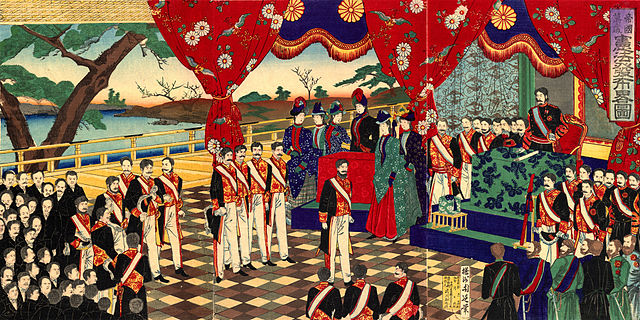 the
day-to-day details as long as they stayed within bounds. The
emperor selected his ministers himself, regardless of what
parliament wanted. Only the upper level of taxpayers was allowed
to vote. The original restrictions limited the vote to about 1%
of the population, but over the next couple of decades, the
franchise was expanded bit by bit.
the
day-to-day details as long as they stayed within bounds. The
emperor selected his ministers himself, regardless of what
parliament wanted. Only the upper level of taxpayers was allowed
to vote. The original restrictions limited the vote to about 1%
of the population, but over the next couple of decades, the
franchise was expanded bit by bit.
More important on the world stage was Japan’s commitment to military modernization. They began to take an aggressive interest in vulnerable territories up and down the Pacific coast of Asia. This eventually generated a war with Russia for control of Manchuria (1904-05), and the Japanese dominated the fighting right from the start. They destroyed Russia’s Pacific Fleet and systematically battered the Russian army, pushing it back and bringing the survivors under siege. When the Russians sent their Baltic Fleet all the way to the other side of the world to help out, the Japanese destroyed it as soon as it arrived.
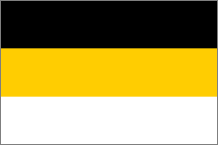 Russia
was widely considered the most oppressive country in
Christendom, and taxing and drafting the peasantry for a bloody,
faraway war in Manchuria was making it worse. In December 1904,
while the war with Japan dragged on badly, Russian workers in
St. Petersburg went on strike for better working conditions. On
Sunday, January 22, 1905, a large crowd of these workers marched
peacefully toward the emperor’s winter palace to deliver a
petition, but jittery palace guards fired into the crowd and
stampeded them into panic. When Bloody Sunday was over,
hundreds of people were dead.
Russia
was widely considered the most oppressive country in
Christendom, and taxing and drafting the peasantry for a bloody,
faraway war in Manchuria was making it worse. In December 1904,
while the war with Japan dragged on badly, Russian workers in
St. Petersburg went on strike for better working conditions. On
Sunday, January 22, 1905, a large crowd of these workers marched
peacefully toward the emperor’s winter palace to deliver a
petition, but jittery palace guards fired into the crowd and
stampeded them into panic. When Bloody Sunday was over,
hundreds of people were dead.
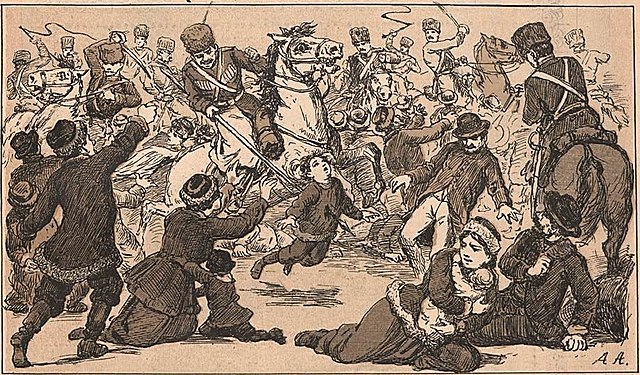 All
the simmering discontent over problems in Russia – ethnic
divisions, working conditions, peasant poverty, political
tyranny and deadly military mismanagement – now exploded in
anger. A full revolution erupted all across the empire. The
government eventually brought the country back under control,
but, as part of a package of compromises needed to defuse
discontent, Tsar Nicholas II adopted a constitution, the first
such limitation on the tsar’s power in history. It did little
more than formalize the tsar’s power and create a parliament of
limited duties, elected indirectly by various classes and
nationalities using complicated formulas, but technically it
shifted Russia from an autocracy to a constitutional monarchy so
it was a big deal at the time. Even so, Tsar Nicholas seemed a
bit unclear on the essential concept behind a constitution, and
he was unilaterally changing it within a couple of years to
elect more landowners who agreed with him and fewer peasants who
didn’t.
All
the simmering discontent over problems in Russia – ethnic
divisions, working conditions, peasant poverty, political
tyranny and deadly military mismanagement – now exploded in
anger. A full revolution erupted all across the empire. The
government eventually brought the country back under control,
but, as part of a package of compromises needed to defuse
discontent, Tsar Nicholas II adopted a constitution, the first
such limitation on the tsar’s power in history. It did little
more than formalize the tsar’s power and create a parliament of
limited duties, elected indirectly by various classes and
nationalities using complicated formulas, but technically it
shifted Russia from an autocracy to a constitutional monarchy so
it was a big deal at the time. Even so, Tsar Nicholas seemed a
bit unclear on the essential concept behind a constitution, and
he was unilaterally changing it within a couple of years to
elect more landowners who agreed with him and fewer peasants who
didn’t.
Upheavals All Around the World
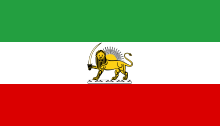 Living
the good life, Emperor (Shah) Mozaffar ad-Din of Persia
(Iran) outspent his allowance and drove the country deeper into
debt. In December 1905, protests erupted among urban shopkeepers
who were being forced to pay higher taxes to cover this.
As protests escalated to riots, the Shah broke down and
agreed to set up a parliament, limiting the powers of the crown.
A nearly democratic constitution took effect in August 1906, and
for a moment it seemed like everyone would stick to it, but this
secular constitution upset the religious leaders of Iran, so
within a year, they pushed through revisions that allowed a
committee of clerics to veto any new law that they deemed
contrary to the basic principles of Islam. By now, however, the
old shah had died and his son Mohammad Ali Shah took over. He
sent troops to break up parliament, and his artillery bombarded
the building when the lawmakers tried to be stubborn. The shah
executed several constitutionalists
Living
the good life, Emperor (Shah) Mozaffar ad-Din of Persia
(Iran) outspent his allowance and drove the country deeper into
debt. In December 1905, protests erupted among urban shopkeepers
who were being forced to pay higher taxes to cover this.
As protests escalated to riots, the Shah broke down and
agreed to set up a parliament, limiting the powers of the crown.
A nearly democratic constitution took effect in August 1906, and
for a moment it seemed like everyone would stick to it, but this
secular constitution upset the religious leaders of Iran, so
within a year, they pushed through revisions that allowed a
committee of clerics to veto any new law that they deemed
contrary to the basic principles of Islam. By now, however, the
old shah had died and his son Mohammad Ali Shah took over. He
sent troops to break up parliament, and his artillery bombarded
the building when the lawmakers tried to be stubborn. The shah
executed several constitutionalists and went
back to being an absolute monarch. After a couple of years, the
constitutionalists regrouped in the provinces, marched
back in and deposed him in favor of his 11-year-old son, Ahmad
Shah, who indulged his pleasures and left the actual ruling to
parliament.
However, the disturbances in the capital became a part of an overall descent into national chaos, with a rebellion by nomads and a widespread outbreak of bandits and warlords in the provinces. British and Russian forces occupied strategic or oil-producing bits of Iran to keep Persian chaos from interfering with the First World War, and then stuck around to keep Russian Bolsheviks from spilling over into Persia. Eventually a military coup in 1921 by Colonel Reza Khan who commanded elite forces in the capital put a stop to the chaos, the foreign occupation and the whole democratic experiment.
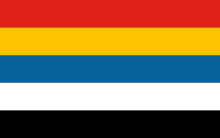 China
also flirted with democracy about this time without actually
consummating the relationship. Modernist sympathies were
especially strong in the army, one of the few Chinese
institutions that preferred technology and meritocracy over
tradition. A provincial army revolt in favor of a republic began
in October 1911 and shattered the empire. As local republican
garrisons gained the upper hand over loyalist units, the central
commander in Beijing, Yuan Shikai, convinced the emperor
China
also flirted with democracy about this time without actually
consummating the relationship. Modernist sympathies were
especially strong in the army, one of the few Chinese
institutions that preferred technology and meritocracy over
tradition. A provincial army revolt in favor of a republic began
in October 1911 and shattered the empire. As local republican
garrisons gained the upper hand over loyalist units, the central
commander in Beijing, Yuan Shikai, convinced the emperor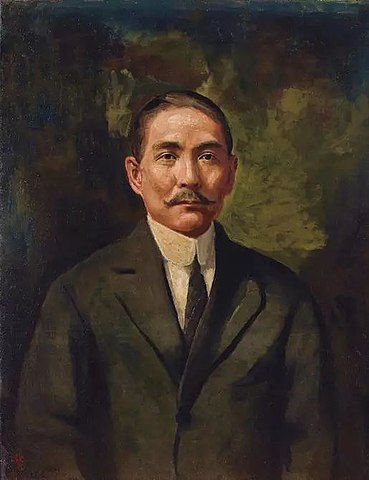 to give up and
abdicate. Sun Yatsen, an American-educated Chinese
Christian who had been the leader of the republican movement for
many years, hurried home from a fund-raising tour of America to
be proclaimed provisional president of the Republic of China,
but General Yuan Shikai refused to surrender control of either
Beijing or the troops at his command. To avoid civil war, Sun
Yatsen handed the presidency over to him until elections could
be held. For a brief moment, the republic hung in the balance as
everyone played nicely. In elections held at the end of 1912,
men of means who had lived in a district for at least two years
were allowed to vote for electors, who then voted for delegates
to the National Assembly. A broad coalition of old-school
liberal republicans called the Kuomintang (Nationalist Party)
came out ahead, but their leader in parliament was quickly
assassinated, probably by agents of Juan Shikai, who soon
consolidated enough power to shut down the legislature and send
everyone home.
to give up and
abdicate. Sun Yatsen, an American-educated Chinese
Christian who had been the leader of the republican movement for
many years, hurried home from a fund-raising tour of America to
be proclaimed provisional president of the Republic of China,
but General Yuan Shikai refused to surrender control of either
Beijing or the troops at his command. To avoid civil war, Sun
Yatsen handed the presidency over to him until elections could
be held. For a brief moment, the republic hung in the balance as
everyone played nicely. In elections held at the end of 1912,
men of means who had lived in a district for at least two years
were allowed to vote for electors, who then voted for delegates
to the National Assembly. A broad coalition of old-school
liberal republicans called the Kuomintang (Nationalist Party)
came out ahead, but their leader in parliament was quickly
assassinated, probably by agents of Juan Shikai, who soon
consolidated enough power to shut down the legislature and send
everyone home.
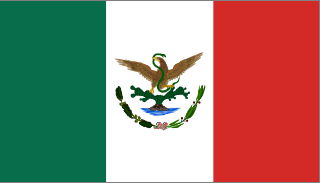 As
we’ve seen, sometimes Mexico came tantalizingly
close to democracy, and on paper they had the structure of a
liberal republic, but the government never stabilized long
enough to become anything in particular until Porfirio Diaz set
himself up as dictator in 1876. Thirty-five years of tyrannical
rule later, he had turned Mexico into his own private estate.
Nothing happened in Mexico without Diaz giving his permission
and getting a payoff. In much of Mexico, the agricultural masses
were held in virtual bondage on large haciendas, at the mercy of
the wealthy land barons. A small middle class lived in a few
cities.
As
we’ve seen, sometimes Mexico came tantalizingly
close to democracy, and on paper they had the structure of a
liberal republic, but the government never stabilized long
enough to become anything in particular until Porfirio Diaz set
himself up as dictator in 1876. Thirty-five years of tyrannical
rule later, he had turned Mexico into his own private estate.
Nothing happened in Mexico without Diaz giving his permission
and getting a payoff. In much of Mexico, the agricultural masses
were held in virtual bondage on large haciendas, at the mercy of
the wealthy land barons. A small middle class lived in a few
cities.
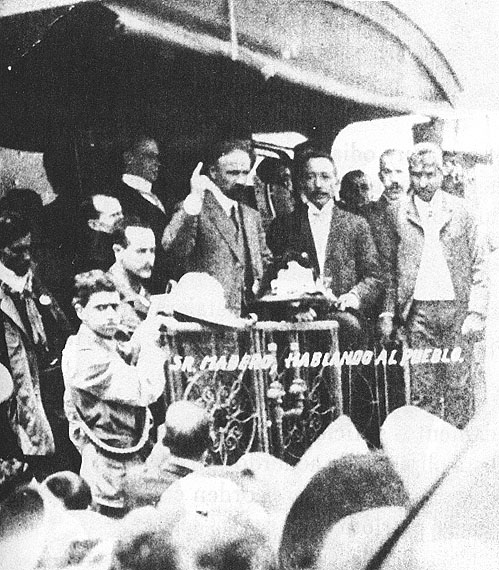 The
1910 election was supposed to just rubber-stamp another
presidential term for Diaz, but one son of a wealthy family, Francisco
Madero, had been educated in Europe and indoctrinated with
all sorts of modernist notions. He jumped into the 1910
presidential race as a real candidate, forcing Diaz to arrest
him and exile him to the United States before declaring himself
massively reelected. The fact that Madero had gotten far enough
to threaten Diaz’ grip on power demonstrated how vulnerable Diaz
had become, so several grassroots revolutions ignited and drove
him out. Madero returned to claim his place as president of
Mexico and tried to install democratic principles, but he was
soon assassinated in a coup by his top general. Civil war
continued in Mexico as a confusing free-for-all of factions
until General Alvaro Obregon emerged as the sole survivor and
new president in 1920. Although small insurrections continued to
flare up now and then, Obregon and his successor Plutarco Elías
Calles finally stabilized Mexico by bundling every faction that
mattered into a single authoritarian party that ran everything,
called the Institutional Revolutionary Party or PRI when they
finally settled on a name.
The
1910 election was supposed to just rubber-stamp another
presidential term for Diaz, but one son of a wealthy family, Francisco
Madero, had been educated in Europe and indoctrinated with
all sorts of modernist notions. He jumped into the 1910
presidential race as a real candidate, forcing Diaz to arrest
him and exile him to the United States before declaring himself
massively reelected. The fact that Madero had gotten far enough
to threaten Diaz’ grip on power demonstrated how vulnerable Diaz
had become, so several grassroots revolutions ignited and drove
him out. Madero returned to claim his place as president of
Mexico and tried to install democratic principles, but he was
soon assassinated in a coup by his top general. Civil war
continued in Mexico as a confusing free-for-all of factions
until General Alvaro Obregon emerged as the sole survivor and
new president in 1920. Although small insurrections continued to
flare up now and then, Obregon and his successor Plutarco Elías
Calles finally stabilized Mexico by bundling every faction that
mattered into a single authoritarian party that ran everything,
called the Institutional Revolutionary Party or PRI when they
finally settled on a name.
Catching Up in Northern Europe
Nowadays we think of all the blond monarchies of the midnight sun as being extremely relaxed democracies with long life expectancies and high standards of social responsibility; however, throughout most of the nineteenth century, the lands behind the Herring Curtain were still one or two steps behind the major trendsetters in democratic governing. To be thorough, I’ll run down the basic events here, but be warned. Without all the fire and mayhem of the continental countries, the Nordic lands are boringly civilized countries with boringly civilized histories
The northern kingdoms had generally been forced to set up half-hearted constitutions earlier in the nineteenth century, often under pressure from mobs in 1848, but those still limited the political participation of ordinary citizens and kept the vote in the hands of men of means. Between 1890 and 1920, however, they all followed the mood of Europe and shifted towards more fully democratic governments. Much of this happened as part of the labor movement. As ordinary workers came to appreciate the power of a long strike to force change, they began to demand less disruptive ways of influencing government, such as universal franchise, and the ruling class found it best to give it to them rather than face more strikes.
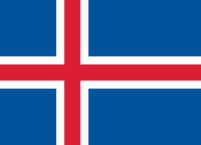 Iceland
often claims to be the world’s oldest democracy because its
parliament, the Althing, dates back to 930; however, only men of
property (specifically: at least one cow per adult in the
household) were allowed to attend the Althing or elect
representatives. Then Iceland lost its independence for almost
700 years when the King of Norway took over the Icelandic
Commonwealth in 1262. Later, Norway fused with Denmark, but when
the Scandinavian kingdoms later divorced, Denmark got custody of
Iceland. Iceland held co-equal sovereignty until Denmark became
an absolute monarchy in 1665, and the king stripped the Althing
of its legislative authority. The Althing served mostly as a
court of appeals for the next century and a half. The king
finally replaced the full parliamentary Althing in 1799 with a
streamlined high court of three appointed judges.Ⓑ
Iceland
often claims to be the world’s oldest democracy because its
parliament, the Althing, dates back to 930; however, only men of
property (specifically: at least one cow per adult in the
household) were allowed to attend the Althing or elect
representatives. Then Iceland lost its independence for almost
700 years when the King of Norway took over the Icelandic
Commonwealth in 1262. Later, Norway fused with Denmark, but when
the Scandinavian kingdoms later divorced, Denmark got custody of
Iceland. Iceland held co-equal sovereignty until Denmark became
an absolute monarchy in 1665, and the king stripped the Althing
of its legislative authority. The Althing served mostly as a
court of appeals for the next century and a half. The king
finally replaced the full parliamentary Althing in 1799 with a
streamlined high court of three appointed judges.Ⓑ
The Althing was restored in 1845 as part of the general liberalizing of Europe, but only the richest men on the island could vote (about 5% of the population) for 20 of its members, while another 6 members were appointed directly by the king of Denmark. It wasn’t until 1916 that all Icelandic grownups regardless of wealth or gender were allowed to vote, so that’s probably the real beginning of democracy in Iceland. Iceland was finally elevated to a sovereign realm of the Danish king in 1918.
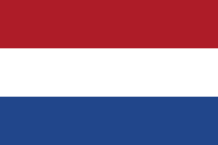 Often
internal forces were nudged along by external events. Because of
the careful balancing act needed to keep the Netherlands
neutral while the First World War swirled all around them, rival
Dutch politicians learned to cooperate with one another for the
greater good and soon negotiated a whole package of changes
among themselves called the Pacification of 1917, in which
everybody got a little something. The Social Democrats got
universal male suffrage. The Christian Democrats got equal
funding for all schools both secular and religious. The small
but stubborn Liberal Party got proportional representation in
parliament instead of geographic winner-take-all.Ⓒ
Often
internal forces were nudged along by external events. Because of
the careful balancing act needed to keep the Netherlands
neutral while the First World War swirled all around them, rival
Dutch politicians learned to cooperate with one another for the
greater good and soon negotiated a whole package of changes
among themselves called the Pacification of 1917, in which
everybody got a little something. The Social Democrats got
universal male suffrage. The Christian Democrats got equal
funding for all schools both secular and religious. The small
but stubborn Liberal Party got proportional representation in
parliament instead of geographic winner-take-all.Ⓒ
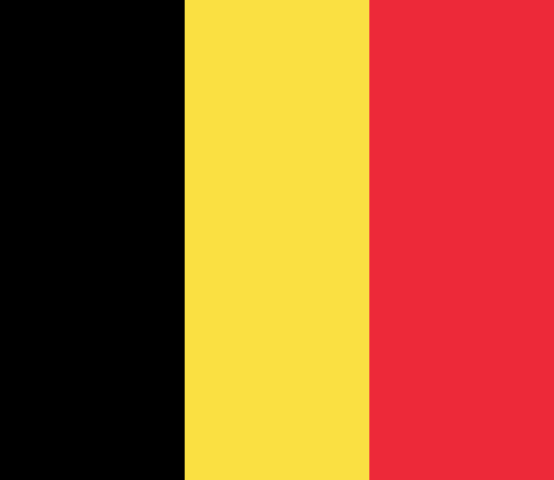 After massive
workers’ strikes shut down the economy in 1893, the government
of Belgium broke down and abolished its tax
qualifications required for voting, and when it held its first
elections with universal male suffrage in October 1894, the
number of voters increased tenfold; however, to keep the rank
and file electorate from getting too cocky, Belgium allowed
certain favored overachievers to cast two, three or even four
extra votes if they had a family, a college degree or lots of
money – a system known as plural voting. Belgium only equalized
male suffrage in 1919 after the massive shared suffering of the
First World War made it difficult to insist that some Belgians
were more important than others.
After massive
workers’ strikes shut down the economy in 1893, the government
of Belgium broke down and abolished its tax
qualifications required for voting, and when it held its first
elections with universal male suffrage in October 1894, the
number of voters increased tenfold; however, to keep the rank
and file electorate from getting too cocky, Belgium allowed
certain favored overachievers to cast two, three or even four
extra votes if they had a family, a college degree or lots of
money – a system known as plural voting. Belgium only equalized
male suffrage in 1919 after the massive shared suffering of the
First World War made it difficult to insist that some Belgians
were more important than others.
 In Luxembourg,
constitutional amendments in May 1919 transferred national
sovereignty from the monarch to the people. Parliamentary
elections in Luxembourg in October 1919 were the first to be
held using proportional party representation after universal
suffrage increased the electorate from 6% of the population to
42%.
In Luxembourg,
constitutional amendments in May 1919 transferred national
sovereignty from the monarch to the people. Parliamentary
elections in Luxembourg in October 1919 were the first to be
held using proportional party representation after universal
suffrage increased the electorate from 6% of the population to
42%.
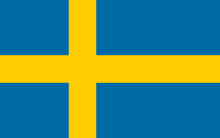 In Sweden,
according to the Instrument of Government of 1809, the king was
ultimately in charge of ordinary government operations, and
parliament only had control of the budget. That hadn’t been a
problem for a long time because the king and the wealthy
conservatives who ran parliament agreed on all the important
issues; however, when the right to vote was extended to all men
in time for the 1911 elections, the Social Democrats suddenly
became the leading party of parliament. In February 1914, during
the European arms race that would climax in the First World War,
King Gustav V wanted to boost military spending so Sweden could
stand up to its neighbors if necessary. When the Social
Democrats refused to authorize more spending, Gustav publicly
griped about it. The government’s ministers took this as an
insult and a threat to the whole parliamentary tradition, so
they all quit in a huff. Gustav, however, just replaced them
with more cooperative conservatives who would gladly give him
his money -- problem solved. Then the socialists won the 1917
elections, so the issue came up again. This time, however, with
the Russian Revolution burning out of control just across the
Baltic Sea, the king didn’t want to antagonize the working
class, so he was forced to accept that parliament was ultimately
in charge. Although this change was not officially incorporated
into the written constitution until 1975, most historians date
the beginnings of real democracy in Sweden from 1917.Ⓓ
In Sweden,
according to the Instrument of Government of 1809, the king was
ultimately in charge of ordinary government operations, and
parliament only had control of the budget. That hadn’t been a
problem for a long time because the king and the wealthy
conservatives who ran parliament agreed on all the important
issues; however, when the right to vote was extended to all men
in time for the 1911 elections, the Social Democrats suddenly
became the leading party of parliament. In February 1914, during
the European arms race that would climax in the First World War,
King Gustav V wanted to boost military spending so Sweden could
stand up to its neighbors if necessary. When the Social
Democrats refused to authorize more spending, Gustav publicly
griped about it. The government’s ministers took this as an
insult and a threat to the whole parliamentary tradition, so
they all quit in a huff. Gustav, however, just replaced them
with more cooperative conservatives who would gladly give him
his money -- problem solved. Then the socialists won the 1917
elections, so the issue came up again. This time, however, with
the Russian Revolution burning out of control just across the
Baltic Sea, the king didn’t want to antagonize the working
class, so he was forced to accept that parliament was ultimately
in charge. Although this change was not officially incorporated
into the written constitution until 1975, most historians date
the beginnings of real democracy in Sweden from 1917.Ⓓ
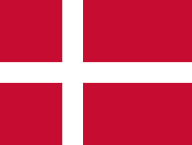 Denmark had gone
through a similar shakeup earlier. The conservatives who ran
parliament in the nineteenth century were happy to leave the
actual governing up to the king because they agreed on most
things. When the left wing began to win elections, however,
parliament began to butt heads with the king. In the 1901
systemskifte (“System Shift”), the king finally admitted that
parliament was in charge after all, although this wasn’t
officially codified until the 1953 constitution.
Denmark had gone
through a similar shakeup earlier. The conservatives who ran
parliament in the nineteenth century were happy to leave the
actual governing up to the king because they agreed on most
things. When the left wing began to win elections, however,
parliament began to butt heads with the king. In the 1901
systemskifte (“System Shift”), the king finally admitted that
parliament was in charge after all, although this wasn’t
officially codified until the 1953 constitution.
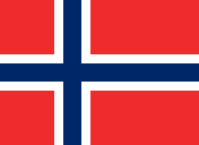 Sweden and Norway
had been fused into a single country after the Napoleonic
Wars. They each kept their own parliaments for domestic
affairs, but they presented a unified face in foreign affairs as
a personal union under the king of Sweden. After nearly a
hundred years, however, the Norwegians had grown tired of being
the kid brother in this arrangement. Swedish interests got
priority over Norwegian in most matters, especially foreign
trade. Finally, the Norwegian parliament declared independence
in June 1905; this was quickly confirmed by a national
plebiscite in August. Sweden and Norway mobilized their troops
and lined them up along the common border but backed down before
anything bad could happen.
Sweden and Norway
had been fused into a single country after the Napoleonic
Wars. They each kept their own parliaments for domestic
affairs, but they presented a unified face in foreign affairs as
a personal union under the king of Sweden. After nearly a
hundred years, however, the Norwegians had grown tired of being
the kid brother in this arrangement. Swedish interests got
priority over Norwegian in most matters, especially foreign
trade. Finally, the Norwegian parliament declared independence
in June 1905; this was quickly confirmed by a national
plebiscite in August. Sweden and Norway mobilized their troops
and lined them up along the common border but backed down before
anything bad could happen.
Norway soon became the first independent country to allow women to vote (1913), although property qualifications applied.
Southern European Periphery
![Before 1910, under the Monarchy [1830 flag of Portugal]](images/1830-Flag_of_Portugal.png) Portugal
was having trouble finding a stable system of government. For a
time, Portugal muddled along as a constitutional monarchy
that allowed the two parties to alternate in power;
however, King Carlos I got fed up with all the partisan
bickering in his parliament, so he appointed João Franco as the
new prime minister and gave him dictatorial powers. In February
1908, republican conspirators shot and killed King Carlos
I of Portugal and his oldest son and heir, Luis Filipe, as they
were returning to the capital from a vacation in the country.
The sudden new teenage king of Portugal, Carlos' second son
Manuel, had never expected to be in charge, so he was out of his
depth and quickly overwhelmed by his duties.
Portugal
was having trouble finding a stable system of government. For a
time, Portugal muddled along as a constitutional monarchy
that allowed the two parties to alternate in power;
however, King Carlos I got fed up with all the partisan
bickering in his parliament, so he appointed João Franco as the
new prime minister and gave him dictatorial powers. In February
1908, republican conspirators shot and killed King Carlos
I of Portugal and his oldest son and heir, Luis Filipe, as they
were returning to the capital from a vacation in the country.
The sudden new teenage king of Portugal, Carlos' second son
Manuel, had never expected to be in charge, so he was out of his
depth and quickly overwhelmed by his duties.
![After 1910, under the Republic [1910 flag of Portugal]](images/1910-Flag_of_Portugal.png) An
uprising in 1910 threw out King Manuel and declared Portugal a republic – only the fourth
in Europe. All male citizens who could read and write were
allowed to vote. The republic was split by factional fighting
right from the start. Among the bitterest disputes, the new
government forcibly separated church from state, earning many
enemies who constantly schemed and plotted to restore the king.
An
uprising in 1910 threw out King Manuel and declared Portugal a republic – only the fourth
in Europe. All male citizens who could read and write were
allowed to vote. The republic was split by factional fighting
right from the start. Among the bitterest disputes, the new
government forcibly separated church from state, earning many
enemies who constantly schemed and plotted to restore the king.
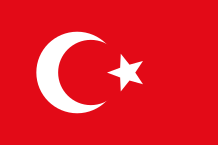 At the other
end of Mediterranean Europe, the Ottoman Empire of
Turkey was in a long, lazy death spiral. Reformers had set up a
constitution in 1876① but this only lasted two years
before the sultan decided that he didn’t like parliament telling
him what to do and he went back to running the empire the way he
wanted. However, the empire continued to erode around the edges.
It lost Greece, Egypt, Bulgaria and Cyprus for example and was
poised to lose much, much more. To stop the drift, a cabal of
modernist army officers called the Young Turks rose up in 1908
and forced the sultan to restore the constitution. When that
didn’t stop the decay of the empire, a triumvirate of
high-ranking Young Turks tightened their control over the sultan
by coup d’état in 1913.
At the other
end of Mediterranean Europe, the Ottoman Empire of
Turkey was in a long, lazy death spiral. Reformers had set up a
constitution in 1876① but this only lasted two years
before the sultan decided that he didn’t like parliament telling
him what to do and he went back to running the empire the way he
wanted. However, the empire continued to erode around the edges.
It lost Greece, Egypt, Bulgaria and Cyprus for example and was
poised to lose much, much more. To stop the drift, a cabal of
modernist army officers called the Young Turks rose up in 1908
and forced the sultan to restore the constitution. When that
didn’t stop the decay of the empire, a triumvirate of
high-ranking Young Turks tightened their control over the sultan
by coup d’état in 1913.
So Ottoman Turkey was drying up and
disappearing, like a puddle in the sun. As the borders shrank,
the Turks left behind formerly oppressed minorities, now able to
stand up and start countries of their own for the first time in
centuries. As the region cluttered up with ethnic ministates, it
left a power vacuum in the Balkans. Two nearby empires aimed to
fill the void. Russia and Austria-Hungary jostled for position
as the new overlords. Austria-Hungary grabbed the 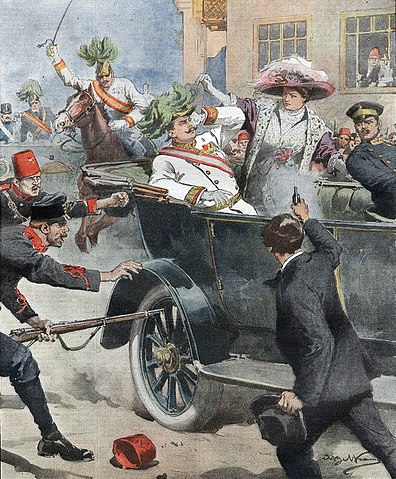 orphaned territory
of Bosnia-Herzegovina, while Russia staked out a big brother’s
protection over their fellow Eastern Orthodox Slavs in the
Kingdom of Serbia. Serbia was hoping to assemble a unified
pan-Slavic state out of all the South Slavic (Yugoslav)
homelands that were slowly emerging as the Ottoman Empire melted
away. Serbian agents began agitating Bosnia to revolt. To
convince the Bosnians that Austro-Hungarian rule wasn’t so bad,
the crown prince of Austria-Hungary, Archduke Francis Ferdinand,
visited Bosnia on a goodwill tour; however, on June 28, 1914,
Serbian terrorists ambushed and killed him as he toured
Sarajevo. After investigators discovered that the conspiracy to
kill the Archduke reached into high places in the Serbian
capital at Belgrade, Austria cranked up its war machine in order
to retaliate; Russia jumped in to protect the Serbs and pretty
soon everyone in Europe was picking sides and gearing up for
all-out war. Germany and Turkey backed Austria-Hungary, while
Serbia could count on the support of the Triple Entente, an
alliance of Russia, France and Britain.
orphaned territory
of Bosnia-Herzegovina, while Russia staked out a big brother’s
protection over their fellow Eastern Orthodox Slavs in the
Kingdom of Serbia. Serbia was hoping to assemble a unified
pan-Slavic state out of all the South Slavic (Yugoslav)
homelands that were slowly emerging as the Ottoman Empire melted
away. Serbian agents began agitating Bosnia to revolt. To
convince the Bosnians that Austro-Hungarian rule wasn’t so bad,
the crown prince of Austria-Hungary, Archduke Francis Ferdinand,
visited Bosnia on a goodwill tour; however, on June 28, 1914,
Serbian terrorists ambushed and killed him as he toured
Sarajevo. After investigators discovered that the conspiracy to
kill the Archduke reached into high places in the Serbian
capital at Belgrade, Austria cranked up its war machine in order
to retaliate; Russia jumped in to protect the Serbs and pretty
soon everyone in Europe was picking sides and gearing up for
all-out war. Germany and Turkey backed Austria-Hungary, while
Serbia could count on the support of the Triple Entente, an
alliance of Russia, France and Britain.
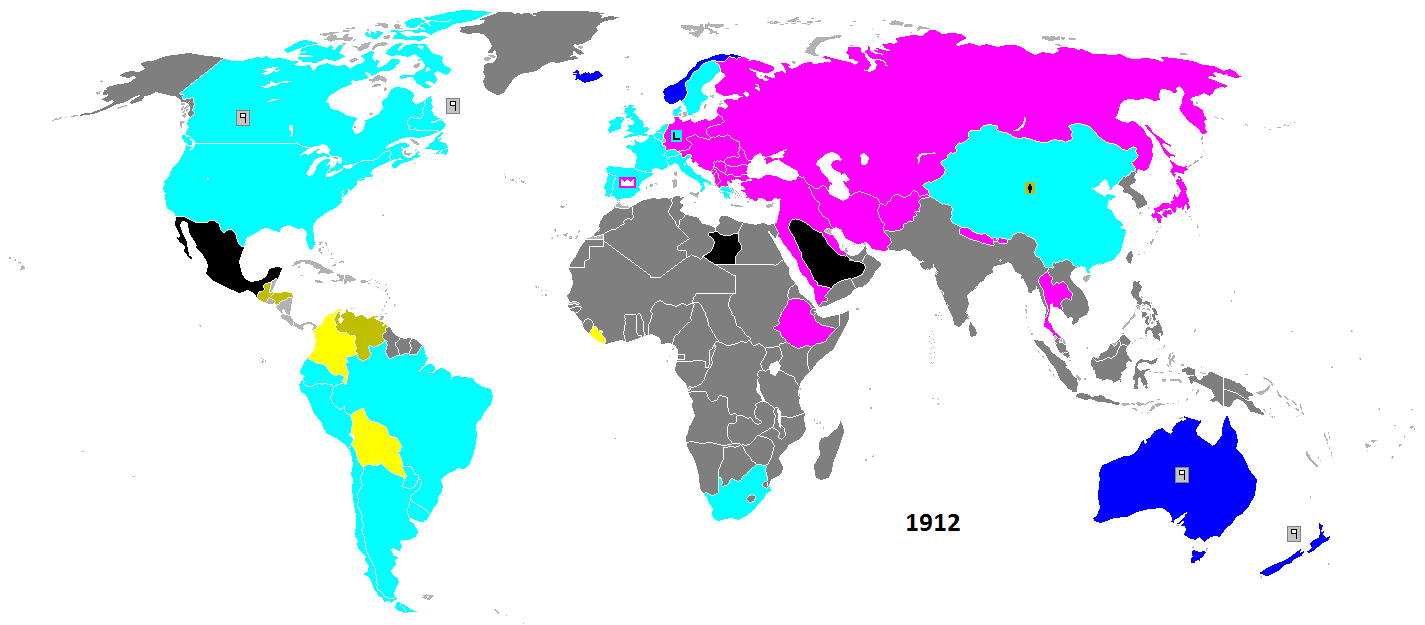
![[Previous Chapter]](images/previous_arrow.gif) |
![[Next Chapter]](images/next_arrow.gif) |
① A definite improvement over the absolute monarchy, the Ottoman Constitution affirmed the legal equality of all subjects of the sultan. However, beyond that, it wasn’t very democratic. The Senate (upper chamber) of the General Assembly (parliament) was appointed by the sultan. The Chamber of Deputies (lower chamber) was elected indirectly, by electors chosen by the people.
Ⓐ Charles Kurzman, Democracy Denied, 1905-1915: Intellectuals and the Fate of Democracy. Cambridge, Mass.: Harvard University Press, 2008.
Ⓑ Gorm Winther, et al., The Political Economy of Northern Regional Development (Nordic Council of Ministers, 2010) Vol. 1 p.
Ⓒ Hans Daalder, Politics in the Netherlands: How Much Change? (Psychology Press, 1989) p.45
Ⓓ Roger D. Congleton, Perfecting Parliament: Constitutional Reform, Liberalism, and the Rise of Western Democracy (Cambridge University Press, 2010) p.402; Kaare Strøm, Wolfgang C. Müller, Torbjörn Bergman, eds., Delegation and Accountability in Parliamentary Democracies (Oxford University Press, Jan 19, 2006) p. 594
Copyright © April 2019 by Matthew White
